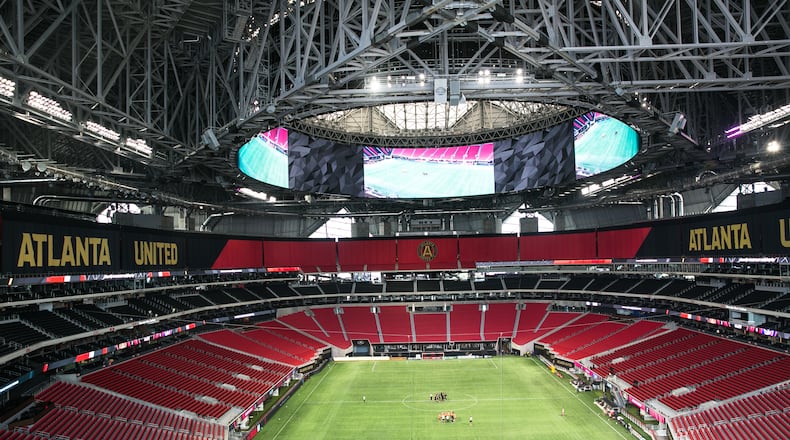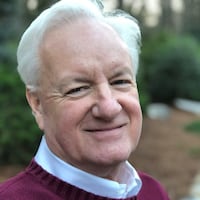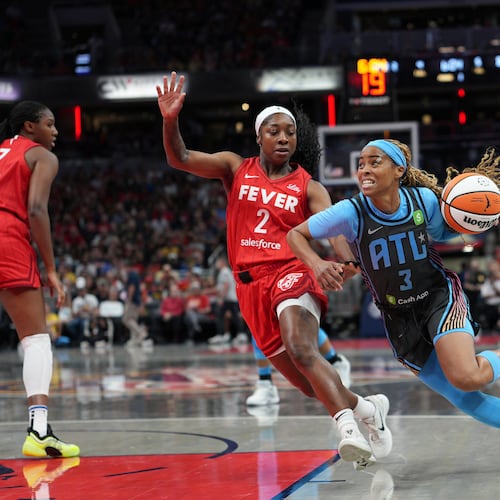Mechanized curtains will hide the upper-deck seats. Rows of seats in the lower-level corners will retract to widen the field. Digital signage will rebrand the building.
Mercedes-Benz Stadium becomes a soccer venue Sunday as Atlanta United plays there for the first time, facing Dallas at 3:30 p.m.
Construction delays on the $1.5 billion stadium forced the MLS expansion team to play its previous nine home matches at Georgia Tech’s Bobby Dodd Stadium, but now the team is set to move into its permanent home, which has hosted two Falcons exhibition games and two college football games since opening Aug. 26.
“It will feel like a different stadium when you come for an Atlanta United game than when you come for a Falcons game,” Atlanta United President Darren Eales said.
Six of the stadium’s next seven events will be soccer games.
Bucking the MLS trend of smaller soccer-specific stadiums, Atlanta United is one of three teams in the league sharing its home with an NFL team. The Seattle Sounders and New England Revolution are the others. Another team, New York City FC, plays in a baseball stadium, Yankee Stadium.
Two of Arthur Blank’s long-time goals – building a new stadium for his Falcons and bringing an MLS franchise to Atlanta – merged to put a second team in Mercedes-Benz Stadium. At least as far back as 2007, he was actively looking at buying an MLS franchise.
“At that time, it would have meant us building a soccer-specific stadium,” Blank said. “We knew eventually we’d have an opportunity to build a new (Falcons) stadium, so it made more sense to wait.”
In early 2013, when architects began designing the new Falcons stadium, they were told to allow for a soccer team. That was more than a year before MLS announced Blank and Atlanta would get a team.
“Soccer played a huge role in designing the stadium,” Falcons President and CEO Rich McKay said.
Football-to-soccer “is not an easy conversion for a stadium,” he said. “It’s a challenge.”
The sports aren’t the most natural fits to share a facility because soccer fields are wider and soccer crowds in this country generally are smaller.
Mercedes-Benz Stadium addressed the first issue with retractable seats in the corners that allow the 53 1/3-yard wide football field to become a 75-yard-wide soccer pitch. This affected about 900 seats.
Soccer fields, like baseball fields, vary in dimensions. Atlanta’s is near the top end of MLS field widths, which range from 70 to 77 yards. (Field lengths in the league range from 110 to 120 yards, with Atlanta’s 115 yards long.)
“You can see that if we couldn’t retract the corner seats we would be in trouble,” Eales said as he stood on the field recently. “It’s something that costs money to do, but it was right thing to do.
“It’s very important … in particular for Atlanta United because we want to go as wide as we can. We are a young dynamic team, and we want to stretch the field. We also want to host the World Cup, and FIFA has dimensions for their international games. A 75-yard-wide pitch puts us in a great position for the World Cup.”
The difference in crowd size generally constitutes another stadium misfit between the NFL, which averages 70,000 fans per game, and MLS, which averages 21,000. That may seem less of a factor here now, considering Atlanta United’s league-leading attendance of 46,318 per game at Georgia Tech, but it was a big issue early in the design of 71,000-seat Mercedes-Benz Stadium.
The architects’ solution was a mechanized curtain system that can conceal the 31,000 upper-deck seats with 14 retractable fabric panels. Each panel measures approximately 40 feet by 130 feet and is attached to the roof structure. Installation was completed Thursday.
The curtain system is designed to reduce the volume of the massive building and create a more intimate environment.
“Now, we’re not sure how much Atlanta United is going to use it,” McKay said.
The upper-level seats are scheduled to be open for two of Atlanta United’s eight remaining home games this season – Sept. 16 against Orlando City and Oct. 22 against Toronto – when the team will seek to break the MLS single-game attendance record of 69,225.
Although the upper-level seats won’t be used Sunday, one part of the top deck will be open: the sky bridge on the east end of the stadium, which has been a popular spot for fans to stand during the building’s first four football games.
Design considerations for soccer extended to the bottom of the stadium, where Atlanta United has its own exclusive locker room – not as large as the Falcons' because an MLS roster has fewer players, but every bit as nice.
“It wasn’t a case of ‘Atlanta United can use the auxiliary locker room or the visiting locker room from American football,’” Eales said as he proudly showed off his team’s locker room. “This is Atlanta United’s only.
“It’s exactly the same look and feel as the Falcons’. That’s important, and (Blank) did that from Day 1. We’re not the little brother to the Falcons, and everything he has done has borne that out.”
At the start of MLS games, the opposing teams’ routes from their locker rooms will carry them through the Delta Sky360 Club and onto the field together at the halfway line, re-creating a pregame ritual from many soccer stadiums in Europe and South America.
“At a lot of shared stadiums in North America, the teams come out from opposite sides, like in American football,” Eales said. “We built it so that … you have that feeling where the whole stadium is waiting and the players erupt out onto the field.”
Stadium officials were not able to achieve another of their goals: a natural-grass field, which is preferred by soccer players. The retractable roof wouldn't allow enough sunlight over the full field for grass to thrive, and the issue was further complicated by the wide range of events planned for the stadium.
“We tried for a long time to solve for grass because we knew everybody would say they’d like to have grass versus artificial turf, including soccer,” McKay said. “It just was not possible.”
For Atlanta United, Sunday’s match starts a week in which the team will play three times at their new home. Then the stadium will be turned back into a football venue for the Falcons’ regular-season home opener Sept. 17.
About the Author
Keep Reading
The Latest
Featured



